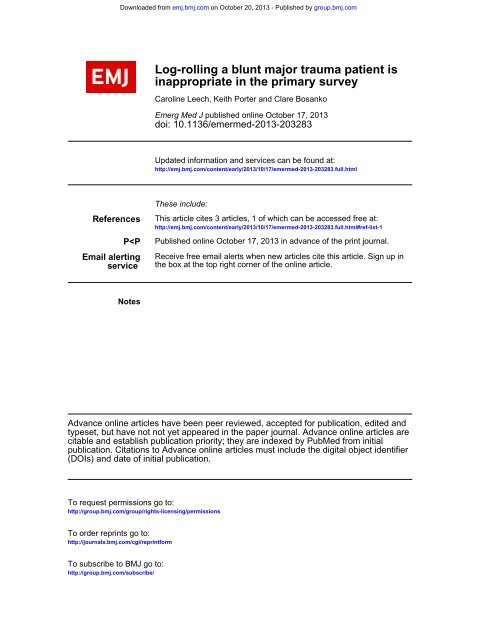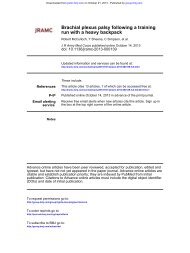Log-rolling a blunt major trauma patient is ... - Koh Tao EMS
Log-rolling a blunt major trauma patient is ... - Koh Tao EMS
Log-rolling a blunt major trauma patient is ... - Koh Tao EMS
Create successful ePaper yourself
Turn your PDF publications into a flip-book with our unique Google optimized e-Paper software.
Downloaded from emj.bmj.com on October 20, 2013 - Publ<strong>is</strong>hed by group.bmj.com<strong>Log</strong>-<strong>rolling</strong> a <strong>blunt</strong> <strong>major</strong> <strong>trauma</strong> <strong>patient</strong> <strong>is</strong>inappropriate in the primary surveyCaroline Leech, Keith Porter and Clare BosankoEmerg Med J publ<strong>is</strong>hed online October 17, 2013doi: 10.1136/emermed-2013-203283Updated information and services can be found at:http://emj.bmj.com/content/early/2013/10/17/emermed-2013-203283.full.htmlReferencesP
Downloaded from emj.bmj.com on October 20, 2013 - Publ<strong>is</strong>hed by group.bmj.comEMJ Online First, publ<strong>is</strong>hed on October 17, 2013 as 10.1136/emermed-2013-203283PostScriptLETTER<strong>Log</strong>-<strong>rolling</strong> a <strong>blunt</strong> <strong>major</strong><strong>trauma</strong> <strong>patient</strong> <strong>is</strong>inappropriate in the primarysurveyThe article by Gill et al 1 provides furtherevidence that a log-roll <strong>is</strong> not useful for<strong>major</strong> <strong>trauma</strong> <strong>patient</strong>s in the primarysurvey. Even with a GCS 15 and no influencefrom alcohol or opiates only 60% of<strong>patient</strong>s with thoracolumbar fractures hadtenderness on log-roll. The authors didnot examine how many false negativeswere found by examination or the impactof a d<strong>is</strong>tracting injury.<strong>Log</strong>-<strong>rolling</strong> a poly<strong>trauma</strong> <strong>patient</strong> in theprimary survey <strong>is</strong> potentially lifethreateningif the <strong>patient</strong> has a site ofinternal haemorrhage as th<strong>is</strong> movementmay lead to clot d<strong>is</strong>ruption and irretrievableexsanguination. The log-roll causespain in the presence of injury and provokesanxiety, which may worsen the<strong>patient</strong>’s physiological state. For <strong>blunt</strong><strong>trauma</strong>, there <strong>is</strong> no evidence that injuriesm<strong>is</strong>sed by inspection of the back will leadto the <strong>patient</strong>’s dem<strong>is</strong>e (although all penetrating<strong>trauma</strong> will require examination ofthe back for occult wounds). Studies havealso shown that the log-roll may inducespinal movement, which may be damagingin the presence of fractures. 23As clinicians at the three adult <strong>major</strong><strong>trauma</strong> centres in the West Midlands weadvocate no log-roll during the primarysurvey for a <strong>blunt</strong> <strong>trauma</strong> <strong>patient</strong> with amechan<strong>is</strong>m of injury triggering a local<strong>major</strong> <strong>trauma</strong> triage tool. The <strong>patient</strong>should instead be transferred supine usinga suitable device, such as an orthopaedicscoop stretcher onto a vacuum mattress orWolverson transfer mattress. While clinicalexamination in the primary survey <strong>is</strong>important, an immediate CT (from headto pelv<strong>is</strong> under the superv<strong>is</strong>ion of the<strong>trauma</strong> team) can rapidly and reliablyexclude life-threatening injuries withoutexamination of the back.When a senior dec<strong>is</strong>ion has been madethat the <strong>patient</strong> does not require a CTscan (or a CT scan has been reported asshowing no internal haemorrhage, v<strong>is</strong>ceralinjury or pelvic fracture) it <strong>is</strong> then appropriateto log-roll the <strong>patient</strong> to assess theback for further injury.Caroline Leech, 1 Keith Porter, 2 Clare Bosanko 31 Emergency Department, University Hospitals Coventry& Warwickshire NHS Trust, Coventry, UK2 Department of Trauma, Queen Elizabeth HospitalBirmingham, Birmingham, UK3 Emergency Department, University Hospital NorthStaffordshire, Stoke, UKCorrespondence to Dr Caroline Leech, UniversityHospitals Coventry & Warwickshire NHS Trust,Emergency Department, Clifford Bridge Road, Coventry,CV2 2DX, UK; caroline.leech@uhcw.nhs.ukCompeting interests None.Provenance and peer review Not comm<strong>is</strong>sioned;internally peer reviewed.To cite Leech C, Porter K, Bosanko C. Emerg Med JPubl<strong>is</strong>hed Online First: [please include Day Month Year]doi:10.1136/emermed-2013-203283Accepted 1 October 2013Emerg Med J 2013;0:1.doi:10.1136/emermed-2013-203283REFERENCES1 Gill DS, et al. Can initial clinical assessment excludethoracolumbar vertebral injury? Emerg Med J2013;30:679–82.2 Suter RE, Tighe TV, Sartori J, et al. Thoraco-lumbarinstability during variations of the log roll maneuver.Prehospital D<strong>is</strong>aster Med 1992;7:133–8.3 MacGuire RA, Neville S, Green BA, et al. Spinalinstability and the log-<strong>rolling</strong> maneuver. J Trauma1987;27:525–31.Copyright Article author (or their employer) 2013. Produced by BMJ Publ<strong>is</strong>hing Group Ltd under licence.Emerg Med J Month 2013 Vol 0 No 0 1





